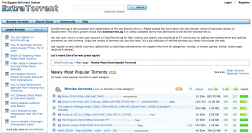Introduction
When it comes to peer-to-peer (P2P) file sharing, privacy and security are of utmost importance. One way to protect your online activities while engaging in P2P file sharing is by using a proxy. But what exactly is a proxy and why should you consider setting one up for your P2P activities?
A proxy acts as an intermediary between your computer and the internet. It acts as a buffer, forwarding your requests to websites and receiving the responses on your behalf. By doing so, it masks your IP address, making it difficult for others to trace your online activities back to your computer.
The main advantage of using a proxy for P2P is the enhanced privacy it provides. Your real IP address is hidden, which means that your identity and location are protected. This can be crucial when engaging in file sharing activities, as it helps prevent copyright holders and intrusive third parties from tracking your online behavior.
Moreover, a proxy can also offer an additional layer of security, as it serves as a barrier between your computer and potentially malicious websites or users. It can help prevent unauthorized access to your personal information and shield you from cyber threats.
There are various types of proxies available, including HTTP proxies, SOCKS proxies, and VPNs. Each type offers different levels of anonymity and encryption. Some proxies even offer features like geo-targeting, allowing you to access region-restricted content.
In this article, we will walk you through the process of setting up a proxy for P2P file sharing. Whether you are new to proxies or just looking for a refresher, this guide will help you get started. So, let’s get into the details of how to set up a proxy for P2P!
What is a Proxy?
A proxy, in the context of computer networking, is a server or an application that acts as an intermediary between your computer and the internet. It receives requests from your computer and forwards them to the intended web server. When the response is received, the proxy sends it back to your computer. This process helps to hide your IP address and adds an extra layer of security and privacy to your online activities.
Proxies work by mediating communication between your computer and the websites or services you access on the internet. Instead of connecting directly to a website, your requests go through the proxy server, which then communicates with the website on your behalf. This means that the website sees the IP address of the proxy server instead of your actual IP address.
There are different types of proxies available, each with its own characteristics that cater to specific needs. One common type is the HTTP proxy, which handles web traffic and is commonly used for browsing the internet. Another type is the SOCKS proxy, which can work with any type of internet traffic and offers more flexibility in terms of protocols and applications.
Proxies also come with various levels of anonymity. Transparent proxies, for example, reveal your IP address to the website you are accessing, while anonymous proxies hide your IP address but still disclose that you are using a proxy. The most secure type is the elite or high-anonymity proxy, which does not reveal any information about your IP address or the fact that you are using a proxy.
In addition to anonymity, proxies can also provide other features like caching, content filtering, and access control. Caching helps to improve browsing speed by storing frequently accessed web pages and serving them from the proxy’s cache instead of fetching them from the original web server. Content filtering allows the proxy to block specific websites or filter out unwanted content. Access control helps to restrict access to certain websites or limit bandwidth usage.
In summary, a proxy is a server or application that acts as a middleman between your computer and the internet. It helps to protect your privacy and security by hiding your IP address and adding an extra layer of protection to your online activities. With different types of proxies available, you can choose the one that best suits your needs and enjoy a safer and more private internet experience.
Why Use a Proxy for P2P?
Peer-to-peer (P2P) file sharing is a popular method for downloading and sharing files among users. However, engaging in P2P activities comes with certain risks, such as exposing your IP address and potentially facing legal consequences due to copyright infringement. This is where using a proxy for P2P can be beneficial. Let’s explore why using a proxy for P2P is a smart choice.
1. Privacy Protection: When you connect to a P2P network, your IP address is visible to other users. This can potentially lead to privacy concerns, as anyone can see your real IP address and track your online activities. By using a proxy, you can hide your IP address, making it difficult for others to trace your online actions back to your device. This adds an extra layer of privacy and reduces the risk of being targeted by malicious users or copyright holders.
2. Anonymity: Proxies provide a level of anonymity by acting as an intermediary between your device and the P2P network. This means that instead of your real IP address being exposed, other users will only see the IP address of the proxy server. This anonymity can help protect your identity and location, ensuring that your online activities remain private.
3. Avoiding ISP Restrictions: Some Internet Service Providers (ISPs) may impose restrictions or throttle P2P file sharing activities. This can result in slower download speeds or even complete blocking of P2P connections. By using a proxy, you can bypass these restrictions as the traffic between your device and the P2P network is encrypted and masked by the proxy server, making it more difficult for your ISP to detect and interfere with your P2P activities.
4. Security Enhancement: P2P networks can be vulnerable to malicious attacks and threats. By routing your P2P traffic through a proxy server, you add an extra layer of security. The proxy server acts as a buffer, filtering out potentially harmful traffic and preventing direct access to your device. This helps protect your computer from malware, viruses, and other online threats commonly found in P2P networks.
5. Accessing Geo-Restricted Content: Some P2P networks may have geographical restrictions, preventing users from certain regions from accessing specific content. By using a proxy located in a different geographic location, you can bypass these restrictions and gain access to content that would otherwise be unavailable in your region.
In summary, using a proxy for P2P provides privacy protection, anonymity, the ability to bypass ISP restrictions, enhanced security, and access to geo-restricted content. These advantages make proxies a valuable tool for anyone engaging in P2P file sharing, allowing for a safer and more unrestricted experience on the network.
Types of Proxies
When it comes to proxies, there are several types available, each offering different features and levels of anonymity. Understanding the different types of proxies can help you make an informed decision on which one to choose for your P2P file sharing needs. Let’s explore some of the common types of proxies:
1. HTTP Proxies: HTTP proxies are specifically designed for handling web traffic and are commonly used for browsing the internet. They work at the application layer of the TCP/IP protocol and can handle various protocols such as HTTP, HTTPS, FTP, and more. HTTP proxies are easy to configure, making them a popular choice for basic web-related activities, including P2P file sharing.
2. SOCKS Proxies: SOCKS proxies operate at the transport layer of the TCP/IP protocol and are more versatile compared to HTTP proxies. They can handle all types of internet traffic, including P2P file sharing, email protocols, and even streaming media. SOCKS proxies offer greater flexibility and can be used with a wider range of applications, making them a popular choice for advanced users.
3. VPN (Virtual Private Network): A VPN is a type of proxy that not only masks your IP address but also encrypts all your internet traffic. It creates a secure and private connection between your device and the VPN server, ensuring that your data is protected from prying eyes. VPNs offer a higher level of security and privacy, making them an ideal choice for users who prioritize anonymity and want to secure their entire internet connection, not just their P2P activities.
4. Residential Proxies: Residential proxies use real IP addresses provided by Internet Service Providers (ISPs) assigned to residential users. They provide a higher level of anonymity as the IP addresses are associated with real residential locations. Residential proxies are often used for tasks that require a more genuine IP address, such as web scraping, as they bypass many IP blocking mechanisms.
5. Dedicated Proxies: Dedicated proxies are exclusively assigned to a single user and are not shared with others. This provides a higher level of control and security, as you have full control over the proxy and can ensure that it is used only by you. Dedicated proxies are often used for activities that require a high level of privacy and security, such as accessing sensitive data or performing automated tasks.
While these are just a few examples, it’s important to note that there are many other types of proxies available. Each type has its own advantages and use cases, so it’s crucial to evaluate your specific needs and requirements before choosing a proxy for your P2P file sharing activities.
Setting Up a Proxy for P2P
Now that you understand the importance of using a proxy for P2P file sharing and the different types of proxies available, let’s dive into the process of setting up a proxy for your P2P activities. Follow these steps to get started:
Step 1: Choose a Proxy Provider: Start by researching and selecting a reliable proxy provider that offers P2P-friendly proxies. Look for providers that prioritize privacy, security, and provide excellent customer support. Additionally, consider factors such as the number of proxy locations available, connection speed, and pricing plans to choose the best option for your needs.
Step 2: Purchase a Proxy Plan: Once you have identified a suitable proxy provider, purchase a proxy plan that aligns with your requirements. The plan should support P2P file sharing and offer sufficient bandwidth and concurrent connections.
Step 3: Set Up Proxy on Your P2P Client/Application: After obtaining your proxy plan, you will likely receive credentials or instructions from the proxy provider. Open your P2P client or application and navigate to the settings or preferences section. Look for an option to configure or set up a proxy. Enter the provided proxy details, including the proxy IP address, the port number, and authentication if required.
Step 4: Configure Proxy Settings: Once you have entered the proxy details, configure any additional settings based on your preferences. For example, you may have the option to enable or disable certain protocols, specify the proxy type (e.g., SOCKS or HTTP), or set authentication credentials.
Step 5: Test the Proxy Connection: To ensure that your proxy connection is working correctly, perform a test by initiating a P2P download. Monitor the connection status and verify that the download is taking place through the proxy. You can confirm this by checking the IP address associated with the download activity, which should match the proxy IP address instead of your real IP.
Congratulations! You have successfully set up a proxy for your P2P file sharing activities. Remember to regularly monitor and maintain the proxy connection to ensure optimal performance and privacy protection.
It’s important to note that the specific steps and settings may vary depending on the proxy provider and the P2P client or application you are using. Refer to the documentation or support resources provided by your proxy provider and P2P client for detailed instructions tailored to your situation.
Step 1: Choose a Proxy Provider
The first step in setting up a proxy for P2P file sharing is to choose a reliable and trustworthy proxy provider. With numerous options available, it’s important to consider several factors before making a decision. This step-by-step guide will help you select a suitable proxy provider for your P2P needs:
1. Research and Evaluate: Begin by researching reputable proxy providers that specialize in P2P file sharing. Look for providers with a proven track record in privacy protection and strong customer feedback. Check online forums and review websites to gather insights from other users’ experiences with different providers.
2. P2P Friendliness: Ensure that the proxy provider explicitly supports P2P file sharing. Not all proxies are designed for this purpose, so it is crucial to choose a provider that explicitly allows and supports it. Check for any limitations on bandwidth, concurrent connections, or specific P2P protocols that may be supported or restricted by the provider.
3. Privacy and Logging Policies: Your chosen proxy provider should have strict privacy policies that prioritize the protection of your personal information and online activities. Look for providers that have a no-logs policy, meaning they do not record or store any data related to your internet usage. Additionally, verify that their privacy policies align with your own privacy requirements and expectations.
4. Proxy Locations: Consider the proxy provider’s server locations. The closer the proxy server is to your physical location, the better the connection speed and overall performance. On the other hand, if you need to access region-restricted content, you may want to choose a provider with servers in multiple geographic regions to bypass those restrictions.
5. Customer Support: Evaluate the quality of customer support offered by the proxy provider. Look for providers that offer responsive and knowledgeable support through various communication channels, such as live chat, email, or phone. Good customer support is crucial when you need assistance with any technical issues or have questions about your proxy service.
6. Pricing and Plans: Review the pricing structure and plans offered by different proxy providers. Compare the features, such as the number of proxies included, bandwidth limits, and support for concurrent connections. Consider your budget and look for providers that offer competitive pricing while still meeting your requirements.
7. Reputation and Reliability: Validate the reputation and reliability of the proxy provider. Look for providers that have been in the industry for a while and have a positive reputation among users. Consider factors like uptime guarantees, server performance, and the provider’s ability to handle high traffic volumes without interruptions.
8. Free Trials or Money-Back Guarantee: If available, take advantage of free trials or money-back guarantees offered by proxy providers. This allows you to test their services and determine if they meet your expectations before committing to a long-term plan.
By following these steps, you can confidently choose a reliable proxy provider that caters to your specific P2P file sharing needs. Take your time to research and evaluate different providers to ensure that you select one that delivers the privacy, performance, and support necessary for a seamless and secure P2P experience.
Step 2: Purchase a Proxy Plan
After selecting a suitable proxy provider for your P2P file sharing needs, the next step is to purchase a proxy plan that aligns with your requirements. This step-by-step guide will help you navigate the process of purchasing a proxy plan:
1. Select the Plan: Take a look at the various proxy plans offered by the provider. Consider factors such as the number of proxies included, the available locations, bandwidth limits, and the support for concurrent connections. Choose the plan that best suits your needs and budget.
2. Subscription Duration: Determine the duration of the proxy plan subscription. Providers typically offer different subscription options such as monthly, quarterly, or annual plans. Consider your usage requirements and decide on the subscription duration that is most suitable for you.
3. Pricing: Understand the pricing structure of the proxy plans. Assess the cost of the plan based on the features and resources provided. Compare the pricing with other proxy providers to ensure you are getting a competitive rate for the services offered.
4. Sign-Up Process: Initiating the sign-up process will usually involve creating an account with the proxy provider. Provide the necessary information, including your email address, and choose a secure password. Some providers may require additional verification steps to ensure the validity of the account.
5. Payment Options: Select a convenient payment method offered by the proxy provider. Popular options include credit/debit cards, PayPal, or cryptocurrencies. Ensure that the payment gateway used by the provider is secure and trustworthy to protect your financial information.
6. Additional features: Review any additional features or add-ons offered by the proxy provider. Some providers may offer advanced features like rotating IPs, simultaneous connection limits, or extended customer support. Assess whether these additional features are necessary for your usage and consider adding them to your plan if required.
7. Review and Confirm: Take a moment to review your selected proxy plan, subscription duration, pricing, and any additional features before proceeding with the purchase. Ensure that all the details are accurate and meet your requirements. If you have any doubts or questions, reach out to the provider’s customer support for clarification.
8. Payment and Activation: Once you are satisfied with the chosen proxy plan and its details, proceed with the payment process. Complete the payment using your preferred method, following the instructions provided by the proxy provider. Upon successful payment, the proxy plan will be activated, and you will receive the necessary credentials and instructions to set up the proxy for your P2P activities.
By following these steps, you can successfully purchase a proxy plan that suits your needs and ensures a secure and reliable proxy service for your P2P file sharing activities.
Step 3: Set Up Proxy on Your P2P Client/Application
Once you have purchased a proxy plan, the next step in setting up a proxy for P2P file sharing is to configure the proxy on your P2P client or application. Here’s a step-by-step guide to help you through the process:
1. Open Your P2P Client/Application: Launch your P2P client or application on your device. This could be a torrent client, an FTP client, or any other software or application you use for P2P file sharing.
2. Navigate to Proxy Settings: Look for the settings or preferences section within your P2P client or application. This is usually accessible from the menu bar or through an icon or button specifically designated for settings.
3. Locate Proxy Configuration: Within the settings, search for the proxy configuration or network settings options. This is where you will enter the proxy details provided by your proxy provider.
4. Enter Proxy IP Address and Port: In the proxy configuration section, locate the fields to enter the proxy IP address and port number. These details should be provided by your proxy provider. Enter the information accurately to ensure a successful proxy connection.
5. Enable Authentication (If Required): Depending on your proxy provider, you may need to enable authentication for the proxy connection. If authentication is required, enter the provided username and password in the respective fields within the proxy configuration section.
6. Choose Proxy Protocol: Select the appropriate proxy protocol based on the options provided by your proxy provider. Common proxy protocols are HTTP and SOCKS. Ensure you choose the correct protocol for your specific proxy setup.
7. Additional Proxy Configuration: Depending on your P2P client or application, you may have access to additional proxy configuration options. These could include enabling DNS resolution through the proxy, tunneling specific traffic through the proxy, or configuring protocol-specific settings. Adjust these settings as needed, following the instructions provided by your proxy provider.
8. Save and Apply Settings: After entering the proxy details and making any necessary configurations, save and apply the settings. This will activate the proxy connection within your P2P client or application.
9. Test the Proxy Connection: To verify that the proxy connection is working correctly, initiate a P2P download or upload within your P2P client or application. Monitor the connection status and check whether the proxy IP and port are being utilized for the transfer. You can confirm this by cross-referencing the proxy IP address and port with the IP address associated with your P2P activity.
By following these steps, you can successfully set up a proxy on your P2P client or application, allowing you to route your P2P traffic through the proxy server for enhanced privacy and security.
Step 4: Configure Proxy Settings
After setting up a proxy for your P2P file sharing activities in your client or application, the next step is to configure the proxy settings to ensure optimal performance and security. Follow these steps to configure the proxy settings:
1. Proxy Type and Protocol: Verify and confirm the proxy type and protocol that you selected during the proxy setup process. Ensure that the proxy type matches the type supported by your proxy provider, such as HTTP or SOCKS, and that the protocol aligns with your specific P2P client or application requirements.
2. Proxy Authentication (If Applicable): If your proxy provider requires authentication, configure the proxy settings to include the provided username and password. This step ensures that your P2P client or application can authenticate with the proxy server before establishing the connection.
3. Proxy Server Location: If your proxy provider offers multiple server locations, you may have the option to specify the location of the proxy server you wish to connect to. Choose the server location that is geographically closest to your physical location for optimal performance and faster transfer speeds.
4. Proxy Port and IP Address: Double-check that the proxy port and IP address entered during the setup process are correct. These details should match the information provided by your proxy provider. If necessary, update the proxy port and IP address fields to reflect the accurate values provided.
5. DNS Resolution: Configure the proxy settings to determine how DNS resolution will be handled. Depending on your preferences and requirements, you may choose to resolve DNS queries through the proxy server or use other DNS resolution methods. Follow the instructions provided by your proxy provider for the recommended DNS resolution configuration.
6. Protocol-Specific Settings: Some P2P clients or applications offer protocol-specific settings that allow further customization of the proxy configuration. For example, you may have the option to specify encryption options, adjust connection limits, or fine-tune specific network protocols. Review your P2P client or application documentation for such protocol-specific settings and optimize them as desired.
7. Saving and Applying Settings: Once you have configured the proxy settings to your satisfaction, save the changes and apply the updated proxy settings. It is essential to follow any prompts or instructions provided by your P2P client or application to ensure that the settings are successfully saved and implemented.
8. Test Proxy Connection: After configuring the proxy settings, perform a quick test to ensure that the proxy is functioning correctly. Initiate a small P2P transfer, such as downloading a small file or connecting to a test torrent, and confirm that the transfer occurs through the proxy and that your real IP address remains hidden.
By carefully configuring the proxy settings in your P2P client or application, you can optimize and tailor the proxy connection to your specific requirements, ensuring a secure and reliable setup for your P2P file sharing activities.
Step 5: Test the Proxy Connection
After setting up and configuring the proxy for your P2P file sharing activities, the final step is to test the proxy connection. This step is crucial to ensure that the proxy is functioning correctly and that your P2P traffic is being routed through the proxy server. Follow these steps to test the proxy connection:
1. Initiate a P2P Transfer: Open your preferred P2P client or application and start a file transfer or download. Choose a small and quick transfer, such as downloading a sample file or connecting to a test torrent, to effectively verify the proxy connection.
2. Monitor Transfer Activity: While the transfer is in progress, monitor the transfer activity within your P2P client or application. Look for any indicators, such as download/upload speeds or progress bars, to ensure that the transfer is actively taking place.
3. Verify Proxy IP and Port: Cross-reference the IP address and port displayed in your P2P client or application with the proxy IP and port provided by your proxy provider. This helps confirm that your P2P traffic is indeed being routed through the proxy server.
4. Confirm Anonymity: Check whether the IP address associated with your P2P activity matches the proxy IP address instead of your real IP address. This indicates that the proxy is successfully hiding your real identity and providing the desired level of anonymity.
5. Monitor Connection Status: Keep an eye on the connection status within your P2P client or application. Ensure that the connection remains stable, without any unexpected disconnects or interruptions, which could indicate issues with the proxy configuration.
6. Verify Speed and Performance: Assess the download/upload speeds and overall performance of the P2P transfer. While the proxy might introduce some overhead due to the additional routing, it shouldn’t significantly impact the transfer speeds or cause a noticeable decrease in performance.
7. P2P Activity Logging: Check whether your proxy provider keeps logs of your P2P activities or not. If your provider offers a strict no-logs policy, you can have peace of mind knowing that your actions are not being tracked or recorded.
8. Troubleshoot if Necessary: If you encounter any issues during the testing process, such as failed transfers, connection errors, or speed inconsistencies, refer to the documentation provided by your proxy provider or seek assistance from their customer support. They should be able to help troubleshoot and resolve any potential problems.
By thorough testing, you can ensure that your proxy connection is working properly, allowing you to enjoy secure and anonymous P2P file sharing. If all the test results match the expected behavior, you can proceed with your P2P activities confidently, knowing that your privacy and security are being safeguarded by the proxy.
Tips for Using Proxies with P2P
Using proxies for P2P file sharing can enhance your privacy and security while engaging in file sharing activities. To make the most out of your proxy setup, consider the following tips:
1. Choose a Reliable and Reputable Proxy Provider: Select a trustworthy proxy provider with a good track record in privacy protection. Research and read reviews to ensure that the provider prioritizes user anonymity and offers high-quality proxy services specifically tailored for P2P file sharing.
2. Monitor Proxy Performance: Keep an eye on the performance of your proxy connection. If you notice any significant decrease in transfer speeds or frequent interruptions, consider switching to a different proxy server location or contacting your proxy provider for assistance.
3. Optimize Proxy Server Location: Select a proxy server location that is geographically close to your physical location. This can help reduce latency and improve transfer speeds for a better overall P2P file sharing experience.
4. Regularly Update Proxy Software: Ensure that you have the latest version of your P2P client or application and any associated proxy software. This helps to maintain compatibility and ensures optimal performance while benefiting from any security updates and enhancements.
5. Test Your Anonymity: Periodically check your IP address and verify that it matches the proxy IP instead of your real IP address. This serves as a confirmation that your proxy setup is effectively hiding your identity and protecting your privacy.
6. Avoid Suspicious Downloads: Be mindful of the files you download and exercise caution when selecting torrents or P2P sources. Avoid downloading files from untrusted or suspicious sources to minimize the risk of malware or copyrighted material.
7. Regularly Review Proxy Provider’s Policies: Stay updated with your proxy provider’s privacy and logging policies. Ensure that they align with your expectations and that your provider maintains a strict no-logs policy to uphold your privacy while engaging in P2P file sharing.
8. Consider Additional Security Measures: While proxies provide an additional layer of security, you may want to consider supplementing your setup with other security measures such as using antivirus software, keeping your operating system and applications up to date, and using a reliable firewall.
9. Utilize Encryption: Consider enabling encryption within your P2P client or application, if available. This helps secure your file transfers and adds an extra layer of protection, especially when sharing sensitive or confidential information.
10. Familiarize Yourself with P2P Laws and Regulations: Stay informed about P2P laws in your jurisdiction to ensure that your file sharing activities comply with legal regulations. This knowledge can help you make more informed decisions and mitigate any legal risks associated with P2P file sharing.
By following these tips, you can maximize the benefits of using proxies for P2P file sharing while maintaining your privacy and security throughout your P2P activities.
Conclusion
Setting up a proxy for P2P file sharing can significantly enhance your privacy, security, and overall P2P experience. Proxies act as intermediaries between your device and the internet, hiding your IP address and adding an extra layer of protection to your online activities. By following the steps outlined in this guide, you can successfully set up and configure a proxy for your P2P client or application.
Choosing a reliable proxy provider that supports P2P file sharing is crucial. Consider factors such as privacy policies, server locations, customer support, and pricing plans when selecting a proxy provider. Once you have chosen a provider, purchase a suitable proxy plan that meets your requirements.
Next, set up the proxy within your P2P client or application by entering the proxy details provided by your proxy provider. Configure the proxy settings, including authentication (if applicable) and protocol-specific options, to optimize your proxy connection.
After setting up and configuring the proxy, it is important to test the connection to ensure that your P2P traffic is successfully routed through the proxy server. Monitor the transfer activity, verify the proxy IP and port, and confirm that your real IP address remains hidden.
To make the most out of your proxy setup, keep in mind the tips provided in this guide. Choose a reputable proxy provider, regularly monitor proxy performance, optimize server location, and consider additional security measures to enhance your overall P2P file sharing experience.
Remember to always comply with relevant P2P laws and regulations in your jurisdiction to avoid legal issues. Stay informed about any updates or changes to these regulations.
By following these guidelines and utilizing proxies effectively, you can enjoy improved privacy, security, and anonymity while engaging in P2P file sharing. Take the time to find a reliable proxy provider, set up and configure the proxy correctly, and regularly monitor the performance of your proxy connection to ensure a seamless and protected P2P file sharing experience.













![Best Torrentz2 Proxy Sites You Should Know [Updated]](https://robots.net/wp-content/uploads/2019/11/torrentz2-eu-home-page-300x200.png)











